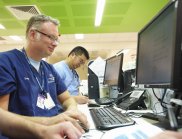The one Toolie that’s welcome at Schoolies

Over 28,000 students will descend on the Gold Coast for the start of schoolies this week, and while the party may be chaos, emergency departments on the Gold Coast already know how many patients will be coming through the door.
Thanks to CSIRO technology hospitals will also know how serious the cases will be and if they will be admitted to hospital.
Dr James Lind, Director of Access and Patient Flow at Gold Coast Health says using CSIRO’s Patient Admission Prediction Tool (PAPT) has been crucial for dealing with big events such as Schoolies, helping to reduce waiting times and ensure schoolies get the best treatment where and when they need it.
“We know in this first week of the Schoolies festival there will be around 2700 presentations to our emergency department in total and around 20 per cent of these will be schoolies,” Dr Lind said.
“Having this information about admissions allows us to plan the staff, medical supplies and beds needed to care for those schoolies and manage waiting times for our other patients who are still arriving with other serious injuries.”
Some of the most common injuries among 17-19 year olds turning up to emergency departments during Schoolies include:
- Mental and behavioural disorders due to intoxication from alcohol (90/wk)
- Grazes or cuts to the head (30/wk)
- Grazes and cuts on the ankle and foot (18/wk)
- Grazes and cuts on the wrist and hand (19/wk)
- Sprain and strains to the ankle and foot (18/wk)
- Drug poisoning (18/wk).
Estimates derived from 2009-2012 schoolies presentation data from Queensland Health.
“We know the majority of presentations during Schoolies are from alcohol intoxication and cuts to the feet from broken glass,” Dr Lind said.
“Our safety message to all Schoolies is to party responsibly and don’t walk on the beach without footwear and most importantly look after your mates.
“For the past few years we’ve been working with Queensland Ambulance Service at the designated medic tent for the first week of Schoolies. We aim to treat as many of these patients on the ground and free up beds in our hospital emergency department for more serious cases, using PAPT we know this is making a real difference.
”David Hansen, CEO of CSIRO’s Australian E-Health Research Centre, said the PAPT software is currently available in 31 hospitals across Queensland and has the potential to save $23 million/per annum in improved service efficiency for the health system if implemented in hospitals across Australia.
“Large events like Schoolies really demonstrate the predictability of emergency departments throughout the year,” Dr Hansen said.
“Our software gives hospitals the information they need to make informed decisions to put in place plans to help them work towards emergency targets even during these peak periods whilst delivering the best care to patients.”
PAPT was developed by CSIRO’s Australian EHealth Research Centre in close collaboration with Queensland Health, Griffith University and Queensland University of Technology.
 Follow
Follow